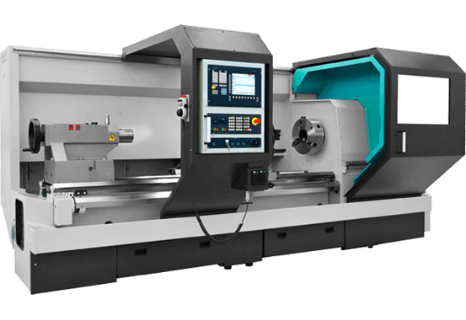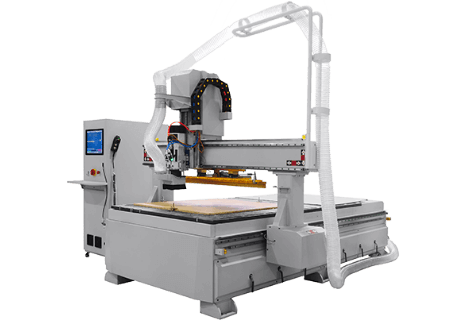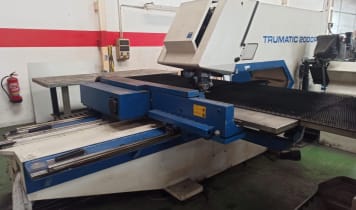Each stage of the sheet metal processing field has its own special range of machinery.
Sheet manufacture
The machines used in sheet manufacture are sheet metal rollers and reels.
Sheet metal rollers
Sheet rollers give the original slabs of metal a flat shape by rolling. Downstream rollers can also be used to transform the sheet into the desired thickness. Three-roll rollers can also be used to bend sheets into rounded shapes.
Reels
The slabs rolled into sheet metal strips are wound on coils on reels. This makes it possible to transform long sheeting into a transportable form. A steel coil can weigh around 30 tonnes and features a diameter of 2.5 metres. Reels can then be used to wind up the coils for onward processing.
Well-known manufacturers of reels and rollers include ALBA, ARKU, KEMMERICH, KOHLER, SCHMITZ and WALDRICH.
Linear sheet cutting
If sheet metal is to be turned into useful products, cutting procedures need to be performed no later than after rolling. Both the ends and the sides of a rolled sheet are unusable in further processing, but industry offers a range of diverse shearing machines featuring very simple but robust mechanics that can cut off the unwanted sections from the sheet.
In the field of production, shearing machines (or: sheet metal cutting tables) are used. They ensure a straight, clean and loss-free cut.
Shearing machines are available in a variety of sizes: small shearers are used in workshops to cutting small sheet parts, such as for chassis construction and maintenance, where they are used to created welded sheeting for repairs. Within large-scale industry, shearing machines are used to create trapezoidal sheets and sandwich panels, as well as prepare panels for edging and coating.
Very high tolerances can be achieved, depending on the quality of material being cut. Longitudinal and cross-sectional systems are also used for processing coils. They cut the coiled sheet in every direction until it has reached the desired width. There are also other machines available that work by dividing that can be used to precisely create sheets. Circular saws and bandsaws are used for linear cuts.
Individual and radial sheet cutting
Radial cuts are made using flame cutting or plasma cutting machines, laser cutting machines, or water-jet cutting machines. These systems can also be used to cut through sheeting that is several centimetres thick, as well as other semi-finished steel products. They primarily differ in terms of purchase price and the precision they can achieve.
Flame cutting and plasma cutting machines
The most affordable cutting machines for individual, radial cuts in sheet panels are flame cutting machines. Nowadays, the cutting tables are operated using a CNC programme and they are ideally suited to very thick material. The flame used makes a very wide cut and also aids in hardening the material along the cut as the heat-affected zone caused by the flame alters the metal’s properties. Plasma cutting devices also work using a flame, but it is much hotter and extremely narrow. They create a cleaner cut than flame cutters, but are far more expensive and complex.
Major manufacturers of sheet shearing machines and cutting machines include PEDDINGHAUS, TRUMPF and WIEGER.
Plasma cutting machines are available from MESSER GRIESHEIM, SATRONIK and VICTOR.
Laser cutting devices
Laser cutting technology is primarily used for cutting thin sheet metal. Laser cutting machines are the most expensive type of hot-cutting machine but the outstanding results they produce are worth the expense.
Laser cutting machines are manufactured by AMADA, BYSTRONIC, PRIMA INDUSTRIE and TRUMPF.
Water jet cutting machines
Those looking for the best precision with a cold cut should look no further than the water jet cutting machine. However, they are similarly expensive as laser cutting systems and have a high maintenance effort.
Water jet cutting machines are manufactured by ESPE, FLOW, MITSUBISHI, PERNDORFER, OMAX and TECHNI.
Many companies combine affordable flame cutting tables with top-notch CNC technology. The products are first pre-cut on a flame cutting machine and then the heat-affected zone is machined on a CNC mill. The products that result are highly precise and can be produced at little expense since machining is a common application in almost every operation.
Machining of sheet metal
Machining equipment is used for more than simply turning profiles and milling solid blocks: the sheet metal processing industry also requires a large number of machining devices for individual, non-linear processing. If the sheeting is not being welded into round pipes, the main tool that is used is the CNC milling machine.
Popular providers of manual and CNC milling machines include DECKEL, HERMLE, MIKRON and HAAS.
Sheet bending
Second-hand Sheet metal machinery
Sheets can always be bent if the ratio between width and thickness is appropriate and the main factor to consider is the size of the machine used. Sheet bending machines can accept massive dimensions if required by the products and constituent materials.
The principle used by these machines (be they linear or radial) is always the same: the sheet metal is led between three rollers whose radius and distance from one another can be set using bending radius and bending depth. When manufacturing linear welded pipes, the bending machines also need to be long enough for the maximum pipe lengths intended.
Spiral seam welded pipes, on the other hand, are different and this process can be used to manufacture pipes with any cross-section and length imaginable. It does not use long sheets, but rather strip material from coils.
The sheet bending machines used in chassis workshops and tank/boiler construction work according to the same three-roller principle but can be made into a much more compact design. The simplest sheet bending machines are available as purely manual devices.
The best-known manufacturers of sheet bending machines are FASTI, KNUTH, HESSE and TOS.
Sheet edging
If a sheet is to be folded rather than bent, sheet edging machines are used. Folding presses are the most basic form of equipment to be found in any metalworking operation, however, they can only press sheet metal linearly in one direction.
Press brakes
Press brakes work using a double-V tool. The sheet is fed between the two halves of the tool which are then brought together under very high pressure. The more the tool is pressed together, the stronger the angle created.
Recommended manufacturers of press brakes include AMADA, CIDAN, GEKA and SCHECHTL.
Swivel bending machines
One of the most popular machines in this field is the swivel bending machine, which enables thin sheet metal to be bent and edged.
Pressing and deep-drawing
If sheet metal needs to be formed individually, rather than simply linearly, presses and deep-drawing presses are the best choice. Normal presses, such as eccentric-, spindle, or toggle presses, can only shape sheet metal by a few millimetres, but this is sufficient for many applications. On the other hand, deep-drawing presses can bring about major shape changes in a piece of metal thanks to high pressure and can alter the sheet as required.
However, presses are purely machine tools which are intended to shape sheets in just one way: in accordance with the shaping tool type. The tools in presses can, however, be changed which enables the pressing profile to be altered. Presses are standard tools in serial metalworking operations and are used in large numbers around the world.
Major manufacturers of presses include DIEFENBACHER, LAUFFER, SMG and SCHULER.
Tool-less flow forming of sheet metals
Flow forming machines
Turning a piece of sheet metal into individual products does not always require a machine tool. A key tool in prototype construction and well-equipped restoration workshops is the free flow forming machine. It enables sheet metal to be formed in almost any way and is indispensable to the classic automobile industry, such as for the manufacture of mud guards.
In an industrial context, automated flow forming machines are used to create bent, rotationally-symmetric parts. Instead of forming blanks using a press- or deep-drawing tool, these machines use three rollers to achieve the same result. Industrial flow forming machines are today available with computerised numerical control (CNC) and can be used to achieve amazingly narrow tolerances.
Major manufacturers of flow forming machines include GROB, LEIFELD and AWAB.
Roll bending machines
If an application simply requires the transformation of sheet metal into cylinders, simple roll bending machines are generally sufficient. These work using the tried-and-tested three-roller principle. The simplest roll bending machines can be operated by hand and are frequently found in workshops. On an industrial scale, roll bending machines are used in pipe construction, boiler construction and for specialist applications.
Popular manufacturers of roll bending machines include HÄUSLER, FOMP, SCHÄFER, PIESOK and STÖLTING.
Straightening sheet metal
Straightening/levelling machines
If tool-less flow forming and bending cannot achieve the desired tolerances, straightening machines are the next choice. They feature a sophisticated system of small rollers and punches and can create any pre-programmed shape from sheet metal. Straightening machines are one of the most complex sheet metal machines and have price tags to match.
Sheet punching
The next most widely used tools in sheet metal processing are punching and notching machines. They do not use shaping processes but rather cut defined pieces from thin sheet metal. They are very similar to presses and, if needed, can also be used for this purpose.
ZERHOCH, AMT, ALBA and SCHLEICHER are well-known for their high-quality straightening machines.
Punching
Punching machines are machine tools that are used on consistently-shaped products and require the right punching tool for the application.
Notching machines
Notching machines, by contrast, can make consistent cuts in a specific cross-section of given piece of sheet metal. Major manufacturers of punches include KAMA, MUHR & BENDER and PEDDINGHAUS.



















































